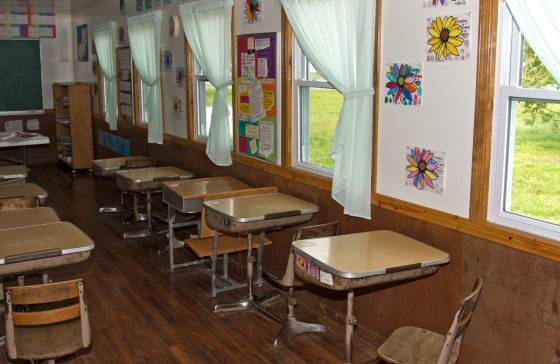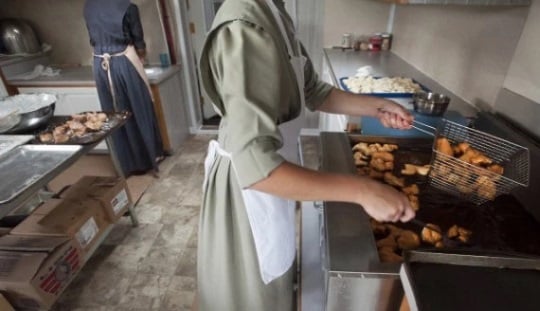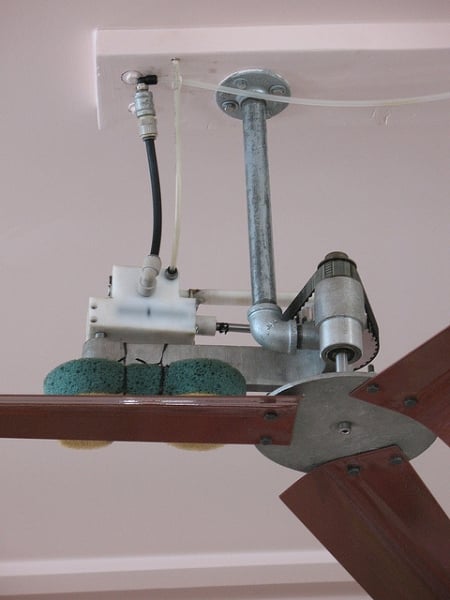Jim Cates: The Real Story of How I Met the Amish
I’m happy to introduce Jim Cates, author of Serving the Amish: A Cultural Guide for Professionals, as a new contributor here at Amish America.
 I know many of us enjoyed reading about Jim’s experiences working with the Amish as a clinical psychologist. You’ll be able to read Jim’s writings here regularly now, in upcoming posts on topics including non-resistance, women’s issues, and the Amish family.
I know many of us enjoyed reading about Jim’s experiences working with the Amish as a clinical psychologist. You’ll be able to read Jim’s writings here regularly now, in upcoming posts on topics including non-resistance, women’s issues, and the Amish family.
But, to start at the start, today Jim shares the story of the special person who first brought him to the Amish.
—
Amish 101
Bloggers arrive at their material in many ways. The source for the journey that led me to Amish America frequently called at 4 a.m. Not that he intended to be a source, and not that those 4 a.m. calls were our first interactions. Let me backtrack and place those sleep-depriving conversations into context.
Erik suggested, and I agree, that those reading my comments in this blog may be curious to know: what led to my interactions with the Amish? My personal involvement came through psychological testing with those from the Elkhart-LaGrange settlement, and for expediency I often share that story as the beginning (“Amish 101”, if you will). However, this story is the real beginning. Think of it as my “remedial” Amish experience.
My late wife was a community health nurse, teaching at a local university in Fort Wayne after many years in practice. A “community health nurse” works within the community rather than a hospital, both caring for patients in their homes and addressing health concerns at the public level. As the 20th century drew to a close, there was an outbreak of a communicable disease among the Pennsylvania Amish.
Easily avoided by vaccination, some Amish still resisted this precaution, both there and near Fort Wayne in the Grabill Indiana settlement. As the two groups visited frequently, the risk of cross-contagion was high. The public health need was clear. Vaccinate the Grabill Amish. However, the “public health need” and the Amish perception of what might be needed did not necessarily coincide.
Those in this area of the state working with the problem consulted my wife, and in turn she visited a lay leader in the Grabill community. The choice of liaisons could not have been a better match. She may have been a master’s prepared community health nurse, but she was raised on a farm in Iowa, and knew planting, plowing, harvesting, and working with a variety of animals.
That first visit, she later shared, barely touched on immunizations. Rather, she and the Amish leader discussed soybeans and corn, cows and horses, and agreed firmly and with utter conviction that hogs were the most difficult animal to raise and handle that a farmer could ever attempt. She warmed immediately to this Old Order man and his wife, and they in turn warmed to her. Following a second meeting the need for immunizations in the community was quietly accepted, and a school chosen as the site for the first Saturday of inoculations.

The day arrived, and my wife and several of her nursing students were on hand, ready to administer the initial vaccinations. Children and mothers began to fill the school and then the yard, talking and laughing as they approached, but growing quiet and still within range of these English nurses. The leader who had spearheaded the event was there beside her, a reassuring presence, but no one dared to be first. This was, after all, a novelty in the community. Somehow, some way, the ice had to be broken.
And as the tension continued to build, this Amish man turned to my wife with a smile, rolled up the white sleeve of his shirt, and said “I’m ready for my vaccination.” She quickly swabbed a spot with alcohol, pricked the skin with a needle, and swabbed the skin once again. He rolled down his sleeve, smiled at the children and asked in dialect “Who’s next?” The line formed immediately, smiles filling their faces.
From that beginning developed a friendship between my wife and this Amish family that flourished over the years. She began a class in Transcultural Nursing, and each semester made arrangements for the students to visit their farm. It was a highlight for many of these nurses-to-be who would otherwise have known the Amish only by rubbing shoulders shopping, in restaurants, or passing a buggy on the road. And we visited their home as a couple too, spending more than one evening talking and laughing as we shared the gifts of food and fellowship.
And those phone calls? Very suddenly and unexpectedly, my wife was diagnosed with a brain tumor. She lived for about a year after the diagnosis, but it was a difficult time, as she was frequently in nursing and rehabilitation centers, fighting to stay alive. Anyone who has experienced a loved one in that situation knows the feeling of dread when the phone rings in the night. And yet, for this man, he was not calling me “in the night.” By 4 a.m. the family’s day was in full swing. He was calling to offer support just before he headed out for his day’s work.
So much in those last few months of her life is a blur. However, as the years pass and I piece together those final days, I can easily recall being jarred awake by the phone. Heart pounding I would answer, to hear that deep, calm voice on the other end asking after our well-being. And that experience reminds me again of the compassion and support that are key to Gelassenheit, the Amish spiritual view. I find myself thankful that my wife shared her experiences with me, and these experiences cued my interest in the Amish, leading me to where I am today.
Jim Cates is author of Serving the Amish: A Cultural Guide for Professionals, published in the Young Series by Johns Hopkins University Press. He is a clinical psychologist in private practice in northeast Indiana. He can be contacted through this blog or his website at servingtheamish.net.






So glad to hear your story
Thanks, Jim, I’m saddened that we never met your wife. She obviously endeared herself to her Amish families and developed lifetime relationships that were passed on to you. I too would wake from those early, early calls, frightened about what accident or death had occurred, only to find Amos, or David, or Jakie wide awake and ready to talk on the other end. When David called me at 4:30 one morning and recognized my groggy voice, he asked if he had wakened me. “That’s okay, David,” I answered, “I had to get up to answer the phone anyway.” We laughed together–and he never called me that early again. But you were obviously blessed by your Amish friend’s concern, even in the pre-dawn hours. Thanks for writing, Jim. I can hear your voice loud and clear. Keep blogging. Rich
I look forward to more articles from Jim Cates.
I got a chuckle about the early morning calls. As a morning person, I need to remind myself not everyone is wide awake just because I am. Our favorite taxi driver does not like phone calls before 6:30 AM unless it’s an emergency.
I do feel for you, Jim, in seeing your wife suffer… It does say a lot about you that your friend cared enough to call like that.
Thank you for sharing this wonderful story with us Jim. I look forward to reading more stories.
Thank you for sharing your story with us, Jim, and I’m so sorry for your loss. I can tell your wife was a very special, loving woman many were blessed to have in their lives. What wonderful experiences you two must have shared! I’m looking forward to reading your entries in the future, too.
And, Erik, thank you for adding Jim’s writings to your great blog! I’m so glad I found your site, and I appreciate all your insights and stories.
Thank you Margaret. I appreciate you being here and contributing. And if you liked this post, I think you’ll enjoy what Jim has coming up.
Thanks, Jim. I guess I need to purchase your book now. One of my daughters is working half time as a Christian counsellor with an organization called Caring for the Heart. She may not exactly be a professional but she has had experiences and training that help her as a plain person working with Amish and Mennonite women who are hurting.
In response to Osiah
Osiah,
Your response leads me to two further comments. First, I am loathe to say to someone “Don’t purchase my book!” but if you are a plain person and are purchasing the book to better understand your daughter’s work, some of the information may hit you as “Duh! Well, of course!” The book is primarily designed to assist English professionals. Second, I hear a sort of, kind of, half-apology there when you say your daughter is “not a professional.” One of the “professionals” I know whose opinion is so important to me when it comes to tough cases has a high school diploma. She is one of the most intuitive people around, and I would much rather have her insights than 3 Ph.D.’s. I suspect we agree – caring about people is not something you can learn, and that’s a huge chunk of what counseling involves. Thanks for your response!
Jim, I am sorry to hear about your wife. Your loss is the community’s loss as well. The world needs more compassionate and intuitive people like her. I look forward to many more of your stories.
Many thanks for sharing!
Thank you for sharing this story with us (or, I should say, the beginning of your story). I, too, would have liked to have met your wife, caring professional and former Iowa farm girl that she was! It’s always so interesting to find out how people “made it” to their chosen profession (or how that profession found THEM.) I look forward to your contributions to this ever-expanding, interesting, educational and oftentimes FUNNY blog!
Thanks to you, too, Erik, for keeping it all running as smoothly as it does.
Alice Mary
What a beautiful, touching story! I look forward to more posts from Jim Cates.
Jim, your wife must have been a very special person. I am glad you shared a bit of her with us.
Erik, I cannot thank you enough for arranging for Jim to post here. I look forward to more of his writings.
Rosemary.
thanks
Thank you so much Jim for sharing this moving story with us.
To me it is clear that your wife must have been a very special one.
Hoping the thankfulness she was yours helps you in getting through pain that you are missing her.
Kind Regards,
Frans
Holland
In response to all these responses!
Thanks to everyone who has responded. I didn’t expect so much sympathy for the loss of my wife. That means a lot to me as well. Looking forward to dialoguing with you in the future!
Welcome
Welcome, Jim, to Amish America, I look forward to your contributions.
Those early morning phone calls are scary, I’ve received several with bad news. Please accept my sympathy on the loss of your dear wife.
We just have to keep moving forward and create a new life, and it sounds like you have done that. I’m hoping to read your book sometime in 2015, I have a stack of TBR books that I’m working on now.
oh, Jim. Tears are running down my face at this article. I am so very sorry for the death of your dear wife. What angels your Amish friends were. They would probably not accept that characterization, but such goodness, kineness, and true concern, and reaching out, is angelic in my book. It is being true believers in our Lord Jesus Christ, as we are to love one another as He has loved us. I am looking forward to reading whatever you choose to write. Oh, and by the way, you have quite a gift for writing.
Welcome Jim
Welcome to Amish America, Jim. Sorry to hear of your loss. Fortunately I have never been through anything like that, I pray that I never do. I am not sure I could face it without a strong support system. Sounds like that is EXACTLY what you had, though 4:00 AM might not have always felt like the IDEAL time to get that support!
I think you will find that this is one of the most unique sites around. Amazing the things that I learn here nearly every time I visit, today was no exception. Well, maybe today I re-learned something. The story about your wife developing a relationship with the lay leader and his family reinforced a lesson that I learned years ago when building a business that is entirely trust based.
I was worrying about my knowledge base and if I had enough understanding of the technical aspects of the business when my mentor told me something that I will never forget. He said: “You know, no one ever cares how much you know … until they know how much you care”. Sounds like your wife cared and her new friends picked up on that pretty quickly. It’s ALL about relationships, isn’t it?
DOK
I really enjoyed this interesting story. You are a good writer and I am looking forward to more posts by you. I also would like to read more posts from non-Amish who have long term friendships with Amish people and how those friendships developed.
Thankful
I’m happy to hear this story & to know that you’ve not only helped the Amish but have published a book for other professionals. Thank you.
Our son-in-law, who grew up and left the uber-strict Swartzentruber Order, was never immunized. As an infant he suffered whopping cough. Having no immunizations is a concern to us now because if our daughter becomes pregnant, we will be on guard that our son-in-law won’t expose her and her unborn baby to a communicable disease.
Our “adopted” son, Monroe, likewise wasn’t immunized. My experiences, family, and friends are mostly from the Swartzentruber Order, which is most resistant to outside doctors and medical care. Even when there was a recent measles outbreak among the Amish here in Ohio, and the Health Dept offered free immunizations, the Swartzentrubers refused. Their attitude is: if they or their child gets sick and dies, it was God’s will.
After reading this string of comments I was just about to ask if I were the only one being a bit surprised at how easily those folks, despite being christians and all, let some nurses come and put needles in them. I think the Swartzentrubers are doing right to refuse that stuff. Mercury, for example, is a common ingredient in many vaccines from what I’ve read. Apparantly it’s used as a preserver. Where I live, they had some (it was voluntary, but the media propaganda for it was fierce) mass vaccination against a simple flu a couple of years ago. What happened was a bunch of people ended up with narcolepsy after taking that poison shot they call vaccine!
And this is just simple poison they’re using right now to experiment on humans, if you wan’t to study what’s coming go search for “nanobots” on the internet. The wickedness of those things is just indescribable. Then I suggest you study the locusts in Rev. 9, also look at Daniels description of Nebukadnessars dream in Dan. 2, where we see the iron mixed with miry clay (the human seed). All this stuff is predicted in God’s Word, and it has everything to do with mans quest for immortality using his own means. I think it says for itself just how such a thing would turn out. Like this verse describes it:
“And in those days shall men seek death, and shall not find it; and shall desire to die, and death shall flee from them.” Rev. 9:6 (KJV).
So what can I say. I’m also a vaccine refuser, my body is my temple and I do NOT want to inject strange things into it! The Swartzentrubers are wise to stay away from those needles. We don’t need them to live our lives with the Lord. We will live here on earth for as long as he allows for anyway, with or without vaccines. The only thing I want to have that near me is the Word of God, that I welcome in me but for anything else, my body is off limits!
“{11} For this commandment which I command thee this day, it is not hidden from thee, neither is it far off. {12} It is not in heaven, that thou shouldest say, Who shall go up for us to heaven, and bring it unto us, that we may hear it, and do it? {13} Neither is it beyond the sea, that thou shouldest say, Who shall go over the sea for us, and bring it unto us, that we may hear it, and do it? {14} But the word is very nigh unto thee, in thy mouth, and in thy heart, that thou mayest do it.” Deut. 30:11-14 (KJV).
May the Lord be with you all. Amen.
Just to clarify, the Holy Ghost is of course also welcome and much needed to reside within me, or else I would be finished. But other than that, I would rather live alone in a hut in the woods than let some nurse sting me with their poison, for whatever reason they may come up with! It’s bad enough that they tricked me (and everyone else) into it when I was a defenseless kid attending the public grade school during the 1990’s. I don’t ever want to get stained by that again!
Response to Marcus
Marcus, your comment raises several important issues: differing views among Christians, the right of the government to insist on a citizen’s welfare, and (indirectly) how to respond to these concerns. I am particularly interested in your comments because I was reading an article last night on nonviolent approaches to contest policies. In the wake of Ferguson, it again raises the difficult issue of responding to perceived injustice. How do we, as people who want to remain calm and compassionate, dialogue about our differences? How do we stand firm for what we believe but practice the nonviolence that so many feel is the Christian response? Your responses are rich with difficult issues that face anyone trying to live a moral life.
When a son joins the Amish
Could someone let me know the dates of the 3 (4?) articles by Anne on “When a Son Joins the Amish”. Thanks so much! And Happy New Year to all……especially to you, Erik. This is absolutely the best site available. And the only “regular” I check every day! Please keep ’em coming! Judy in MN
When a Son Joins the Amish series
Gladly Judy. I hope I’m right in assuming you want the links and not only the dates. There have been 7 posts so far in the series.
In chronological order (the first was posted June 1, 2012, the latest back in September):
https://amishamerica.com/when-a-son-joins-the-amish/
https://amishamerica.com/when-a-son-joins-the-amish-what-about-photos/
https://amishamerica.com/when-a-son-joins-the-amish-how-do-others-react/
https://amishamerica.com/when-a-son-joins-the-amish-dollars-degrees-dentists/
https://amishamerica.com/when-a-son-joins-the-amish-hard-times/
https://amishamerica.com/when-a-son-joins-the-amish-we-are-wimps/
https://amishamerica.com/when-a-son-joins-the-amish-the-only-treasure-you-can-take-to-heaven/
Anne has told me she’d like to write another update but I know she has a lot on her plate right now.
Thanks for making us a part of your day. We plan to keep on trucking 🙂